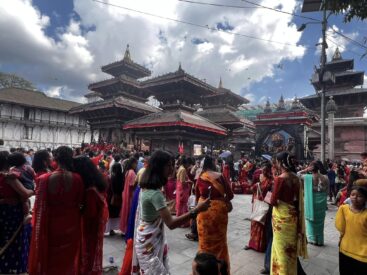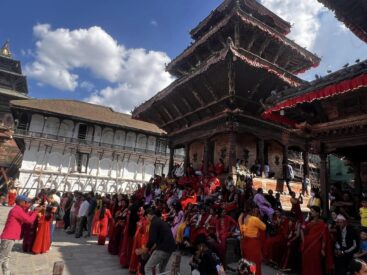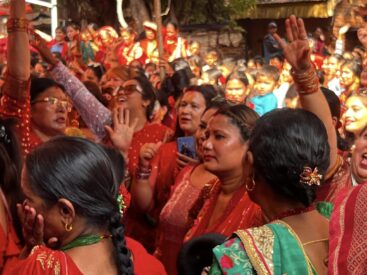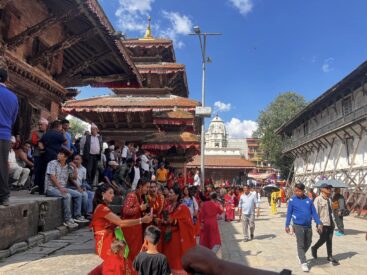Nepal, a land of diverse cultures and traditions, boasts a rich tapestry of festivals that reflect the nation’s deep-rooted spirituality and cultural heritage. Among these vibrant celebrations, Teej Festival holds a special place in the hearts of Nepali women. This 1,500-year-old festival, primarily observed by Hindu women, is a fervent ode to the divine bond between Lord Shiva and Goddess Parvati. Teej is celebrated with great enthusiasm throughout Nepal and is especially prominent in the Kathmandu Valley. In this comprehensive exploration, we will delve into the origins, rituals, and significance of the Teej Festival in Nepal, while also shedding light on its connection to the illustrious Kathmandu Durbar Square. Additionally, we will explore the traditions of fasting and worship that characterize this festival and highlight the subsequent celebrations of Indra Jatra, Dashain, and Tihar that follow in its wake.

Teej traces its origins back to ancient Hindu mythology, specifically the union of Lord Shiva and Goddess Parvati. According to the legend, Goddess Parvati fervently prayed and observed rigorous fasting to win the heart of Lord Shiva, who was eventually moved by her devotion and married her. Teej celebrates this sacred bond between husband and wife, making it a crucial festival for married women in Nepal. Historically, Teej also marked the arrival of the monsoon season, which brought relief to the parched lands of Nepal and hence was celebrated with much enthusiasm. The festival is observed on the third day of Bhadra (August-September) in the lunar calendar and usually falls in August. The date varies each year according to the Gregorian calendar. Teej is primarily celebrated by women, and they are the central figures in the festival’s rituals and ceremonies.

Kathmandu Durbar Square, also known as Basantapur Durbar Square, is a UNESCO World Heritage Site and a testament to Nepal’s rich architectural and cultural heritage. This historic site, located in the heart of Kathmandu, serves as a focal point for various festivals and celebrations, and Teej is no exception.
During Teej, Kathmandu Durbar Square comes alive with a riot of colors, sounds, and fervor. The square is adorned with vibrant decorations. Women, dressed in their finest red and green sarees, gather here in large numbers to celebrate the festival. The square’s architecture, with its stunning palaces and temples, provides a picturesque backdrop for the festivities.

Fasting: Fasting is an integral part of Teej celebrations and is observed by both married and unmarried women. The fast typically begins at dawn and continues until the sighting of the moon, often lasting for 24 hours. During this period, women abstain from food and water as a mark of their devotion and to seek the blessings of Lord Shiva and Goddess Parvati for the well-being and longevity of their husbands. Fasting is seen as a way to purify the body and mind and demonstrate one’s dedication to their spouse.
Worship: Teej is a time for fervent prayer and worship. Women visit temples dedicated to Lord Shiva and Goddess Parvati, such as the Pashupatinath Temple in Kathmandu, to offer their prayers and seek blessings. They light oil lamps, burn incense, and present flowers and fruits as offerings to the deities. Devotional songs and bhajans (hymns) are sung throughout the day, adding to the spiritual atmosphere.
Feasting: While fasting is a central aspect of Teej, feasting also plays a significant role in the festival. After the moon is sighted and the fast is broken, families come together to enjoy a sumptuous meal. Special dishes, including “dar” (a sweet, rice pudding) and “malpuwa” (a sweet fried bread), are prepared for the occasion. The feasting symbolizes the joyous culmination of the fasting period.
Sindoor (Vermilion): Married women apply sindoor (vermilion) to their foreheads as a symbol of their marital status and to pray for the well-being of their husbands.
Processions: Processions featuring idols of Lord Shiva and Goddess Parvati, along with cultural performances, are common during Teej. These processions add a vibrant and festive element to the celebration.

Teej Festival holds profound significance in Nepali society. It not only celebrates the bond between spouses but also serves as a platform for women to express their solidarity, spirituality, and cultural identity. In contemporary times, Teej has evolved to include social aspects as well. Women often use the festival as an opportunity to advocate for gender equality and women’s rights.
Teej has also gained international recognition, attracting tourists from around the world who are eager to experience the vibrant festivities and immerse themselves in Nepali culture. Normally After Teej festival, weather become stable with blue sky and mountain view, as a result, arrival of tourist increases in Nepal for Trekking, Climbing, Jungle Safari as well as many other adventure activities.